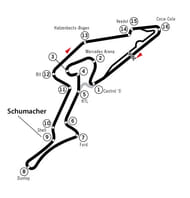There is only a 21-point difference in the Drivers’ Championship between Red Bull’s Sebastian Vettel (L) and Ferrari’s Fernando Alonso. (Getty Images)
Time is at a premium in Formula 1. The teams don’t even have 24 hours between the end of the race at Silverstone and now.
They have to start setting up their garages in Nurburgring, Nurburg, with the German Grand Prix – which has been a favourite fixture (both in its current and old form) – this weekend, as every team tries to adjust to the schedule sanctioned by the FIA.
Right from the start of Free Practice 1 on Friday to the fall of the chequered flag on Sunday, the spotlight will be on the under-fire Pirelli tyres.
To prevent the repeat of the happenings at Silverstone, the Italian tyre manufacturer has announced that the tyres used in Germany will be Kevlar-belted: the ones which had been supplied to the teams during Friday practice in Canada and Great Britian.
This will be a shift from the steel-belted tyres, which have been used since the start of the season but the changes will be made only on the rear tyres.
Tyre choices
With the Nurburgring being less demanding than Silverstone in terms of high speed loads, Pirelli have opted for the Medium and the Soft tyres.
Considering the shorter life of the Softs along with the low temperatures to be experienced in Germany, the Medium tyre should be the better race tyre given the lower operating range of the white-walled tyres.
With the Kevlar-belted tyres being run this weekend, the chances of delaminations are negligible as they were never seen last year when Kevlar belts were used.
Track characteristics
The track, although separately built after the old Nurburgring was deemed unfit for Formula 1 racing, shares a few characteristics with its predecessor. The track overall is narrow with mostly grass banks on either side of the tarmac.
The abrasiveness is low so graining should not be a problem. With the track set in the Eifel Mountains, one striking similarity between the shorter and longer versions of the Nurburgring is the unpredictable weather.
In heavy rain, the track can become undriveable as we saw during the 2007 European Grand Prix when many drivers aquaplaned at Turn 1 and gave rise to what commentators labelled as the “most expensive car park in the world”.
The 5.148 km track features a mixture of slow, medium and high speed corners. The braking demand is medium with the most challenging being Turn 1 when the drivers have to go steeply downhill while braking which can easily result in somebody overshooting the corner or locking up heavily.
The first corner along with the slow speed chicane in the final sector provide the best points for overtaking and if one can place his car correctly going into the chicane, the overtake is guaranteed because the other will have to yield or risk running onto the gravel trap or taking to the escape road.
Kerbs at the Nurburgring also pose a serious challenge because some of them are not flat and that can lift a car into air, severely compromising its balance. To counter that, the teams have the option of running a softer suspension with the compromise being fast direction change.
DRS zones
There will be two DRS zones for this year’s race: one starting after Turn 11 extending through the right kink up to the chicane (Turns 13 and 14). The detection point for this zone will be after the Schumacher S.
The second DRS zone will be the pit straight with the detection point being just before the final corner.
Technical Information
Lap length: 5.148 km
Laps: 60
Race length: 308.9 km
Pit lane speed limit: 60 kph during practice and qualifying, 100 kph during race
Pit lane length: 380 m
Pit lane loss: approx. 18 seconds
Full throttle: 64%
Braking: 18%
Fuel Consumption: 4.86 kg/10 km
Tyre Choices: Soft (Yellow), Medium (White) along with Intermediate (Green) and Wet (Blue)

